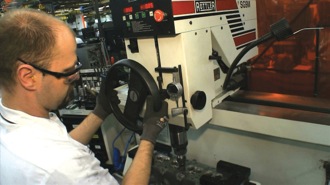If the valve seats are not concentric to the valve guides, the valves will not seal effectively.
When it comes to gas engine re-manufacturing, the subject of valve seat concentricity is a very serious one.
Concentricity, as we are discussing here, is the relation between the centers of the valve guides and the centers of the valve seat surfaces.
“If two circles, one within another, share the same center, they are considered concentric,” says Randy Bauer, gas engine division manager, Jasper Engines & Transmissions. “The circles are non-concentric if one of the circles has a center that is not equal to the other.”
Valve seat concentricity is calculated by the variance between the two centers. “JASPER’s valve seat concentricity specification is 0.002” for every 1 1/2” of valve seat diameter,” said Bauer.
JASPER ihas moved to seat and guide machines with a “dead pilot” design that remains stationary in the guide as the cutting head rotates around it. This design replaces machines with a “live pilot” setup that spins with the cutting head in the guide.
“The dead pilot setup has proven to give JASPER concentricity values into the tens of thousandths of an inch, well within our specifications.”
If the valve seats are not concentric to the valve guides, the valves will not seal effectively.
“Non-concentric valves affect proper heat transfer from the valve to the valve seat and put undo stress on the valve head itself,” added Bauer. “Over time, the valve will fatigue as it tries to conform to the seat. Eventually, the valve stem will break, dropping the valve into the cylinder.”
Courtesy of Jasper Engines & Transmissions, www.jasperengines.com.














